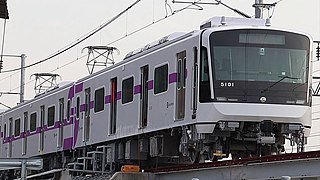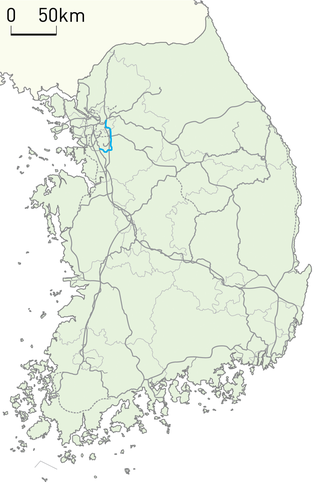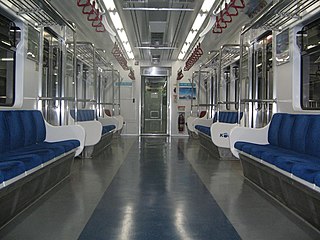
The Seoul Metropolitan Subway is a metropolitan railway system consisting of 23 rapid transit, light metro, commuter rail and people mover lines located in northwest South Korea. The system serves most of the Seoul Metropolitan Area including the Incheon metropolis and satellite cities in Gyeonggi province. Some regional lines in the network stretch out beyond the Seoul Metropolitan Area to rural areas in northern Chungnam province and western Gangwon Province, that lie over 100 km (62 mi) away from the capital.

Seoul Subway Line 5 of the Seoul Metropolitan Subway, dubbed the purple line, is a long line crossing from west to the east across the Seoul National Capital Area, South Korea. It is one of two subway lines in Seoul to cross under the Han River, which is done at two points. The main line runs through to Hanam Geomdansan Station while the branch line from Gangdong Station terminates at Macheon Station. In 2019, Line 5 carried an annual ridership of 334 million or about 915,000 passengers per day.

Goyang is a city in Gyeonggi Province in the north of South Korea. It is part of the Seoul Capital Area, making Goyang one of Seoul's satellite cities. It is one of the largest cities in the Seoul Capital Area, with a population of just over 1 million. Ilsan, a planned city, is located in the Ilsandong-gu and Ilsanseo-gu districts of Goyang. It also includes Deogyang-gu which is closer to Seoul.

Seoul Subway Line 1 of the Seoul Metropolitan Subway is a rapid transit and commuter rail line which links central Seoul, South Korea to Yeoncheon in the northeast, Incheon in the southwest, and Sinchang via Suwon and Cheonan in the south. The central underground portion of Line 1, running underneath Sejongno, Jongno, and Wangsan-ro avenues along Seoul's traditional downtown area, is the oldest subway-operated section in the Seoul Metropolitan Subway system. Its branches and services cover a large part of the Seoul Capital Area; totaling 218.3 km (135.6 mi) in route length.

Seoul Subway Line 2, also known as the Circle Line, is a circular line of the Seoul Metropolitan Subway. The line running clockwise is called the "inner circle line" and the counter-clockwise line is called the "outer circle line". This is Seoul's most heavily used line, and consists of the main loop, the Seongsu Branch and the Sinjeong Branch for a total line length of 60.2 km (37.4 mi). The Line 2 loop is the third longest subway loop in the world after Moscow Metro Bolshaya Koltsevaya line and Beijing Subway Line 10. In 2019, Line 2 had an annual ridership of 812 million passengers or 2.2 million passengers per day.

Seoul Subway Line 4 of the Seoul Metropolitan Subway is a long line crossing from the southwest to the northeast across the Seoul National Capital Area. The central section in Seoul City is operated by Seoul Metro with some trains offering through service to Korail's Ansan and Gwacheon Lines. The southern terminus (Oido) is in Jeongwang 4-dong, Siheung City, and the northern terminus (Jinjeop) is in Jinjeop-eup, Namyangju-si, Gyeonggi-do; the newly built northern section is correspondingly owned by a company owned by Namyangju-si, with operations contracted to Seoul Metro. In 2022, the Seoul Metro operated section had an annual ridership of 219,587,000 or about 601,608 passengers per day.

The Bundang Line or Seoul Metropolitan Subway Bundang Line was a commuter rail line of the Seoul Metropolitan Subway in the Seoul Capital Area operated by Korail. Also it refers physical railway track from Wangsimni to Suwon which is designated by MOLIT. The name 'Bundang Line' refers to the fact that the line was originally constructed for the new planned town of Bundang. The line service started in central eastern Seoul at Cheongnyangni, crossing Gangnam District and connecting the cities of Seongnam and Yongin, and terminates at Suwon Station. While the track 'Bundang Line' designated by MOLIT is from Wangsimni to Suwon.

Seoul Metro Corporation (Korean: 서울메트로) was a municipal-owned corporation owned by the Seoul Metropolitan Government. Established in 1970, it was, with Seoul Metropolitan Rapid Transit Corporation and Korail, one of the major operators of Seoul Metropolitan Subway. The company merged with Seoul Metropolitan Rapid Transit Corporation in 2017.

The Shinbundang Line Korean: 신분당선; Hanja: 新盆唐線; literally, New Bundang Line) or DX Line for Dynamic Express Line is a 33.4 km (20.8 mi) long line of the Seoul Metropolitan Subway. It is the world's fifth subway to run completely driverless and the second completely driverless metro line to open in South Korea, after Busan Subway Line 4. It connects Sinsa station and Gwanggyo station in 42 minutes, a feat achieved by being the first line to operate South Korea's next-generation subway car travelling at over 90 km/h (56 mph), with the fastest average speed of any subway line in the country.

Yangjae Station is a station on the Seoul Subway Line 3 and Shinbundang Line. It was the southern terminus of Line 3 until October 30, 1993, when the line was extended to Suseo station, and it became a transfer station with the Shinbundang Line on October 28, 2011. It is located in Yangjae-dong, Seocho and Gangnam District, Seoul.

There are many types of trains in Seoul but they are generally similar to each other. All Seoul Metropolitan Subway rolling stock follow the Japanese-style commuter/subway train interior layout of all-longitudinal seating with luggage racks above seats. Typically, train cars have four pairs of doors on each side. In between the doors are rows of either cushioned or non-cushioned seats for 7 people, except for the outer ends of each wagon where there are smaller rows of seats for 3 people, marked for the use by the elderly, disabled passengers, and pregnant women.

SuseoStation is a railroad station on the Suin–Bundang Line and Line 3 of the Seoul Metropolitan Subway. The station is in the Suseo neighborhood of the Gangnam District in Seoul, South Korea. Prior to the Line 3 extension to Ogeum station in 2010, Suseo Station was the southeastern terminus of Line 3. Along with Yangjae station, Suseo Station serves as an important transfer point between Line 3 and buses from/to southern cities such as Seongnam, Yongin, and Suwon.

Baekseok station, also known as National Health Insurance Service Ilsan Hospital station, is a subway station served by Seoul Subway Line 3 of the Seoul Metropolitan Subway system. The station is located in the Ilsan ward in Goyang, Gyeonggi Province, South Korea. There are many stores and restaurants close to the station, including a Costco store.

Daegok Station is a station on Seoul Subway Line 3, the Gyeongui–Jungang Line and the Seohae Line. It is located in the city of Goyang, close to Ilsan. It is mainly used as a transfer station between the three lines rather than as an actual enter-and-exit stop, as the station is located in the midst of farmland with very little local resident demand.

Ilsan Line is a subway line operated by Korail, in Seoul, South Korea. Trains from this line continue to and from Seoul Metro's Line 3.

The Seohae Line is a dual-track, electrified rail line in western Gyeonggi-do and Seoul, South Korea. The Seohae Line is being built in four sections simultaneously. The line runs 47 km (29 mi) south from Ilsan in Goyang City, crosses the Han River, passes Gimpo Airport, Sosa, Siheung, and ends in Wonsi in Ansan. There is a transfer to different lines at Daegok, Neunggok, Gimpo Int'l Airport, Bucheon Stadium, Sosa and Choji. There are currently 21 stations (Ilsan-Wonsi). The line is operated by Korail, but the stations between Sosa and Wonsi are managed by SEO HAE RAIL CO.,LTD., which is a subsidiary of Seoul Metro. The infrastructure is also owned by Korail so the line runs on the left like the rest of the South Korean mainline railway network.
Ilsan New Town (Korean: 일산신도시) refers to a planned city occupying Ilsandong-gu and Ilsanseo-gu of Goyang.

The Korail Class 341000 trains, formerly identified as Korail Class 2000 trains, are commuter electric multiple units in South Korea used on Seoul Subway Line 4. Class 341000 trains were manufactured and delivered between 1993 and 1999 to expand service on the Gwacheon Line and the Ansan Line sections of Line 4.

The Korail Class 351000 trains, formerly identified as Korail Class 2000 trains, are commuter electric multiple units in South Korea used on Suin-Bundang Line. Class 351000 trains were manufactured and delivered between 1993.

Seoul Transportation Corporation, branded as Seoul Metro, is a municipal-owned corporation owned by Seoul Metropolitan Government, and one of the two major operators of Seoul Metropolitan Subway with Korail.























